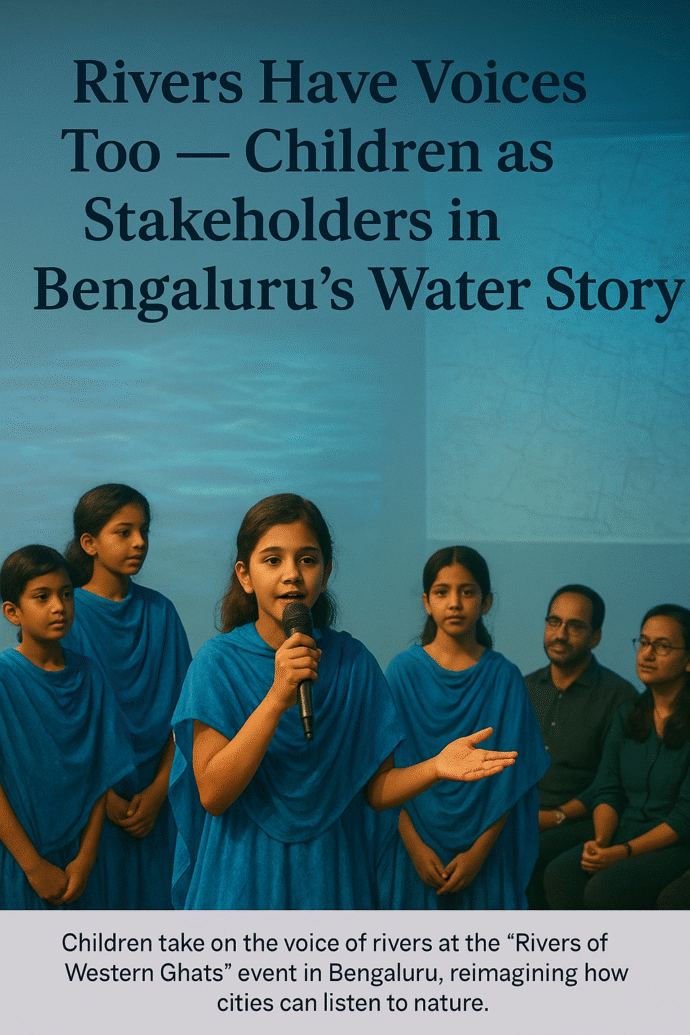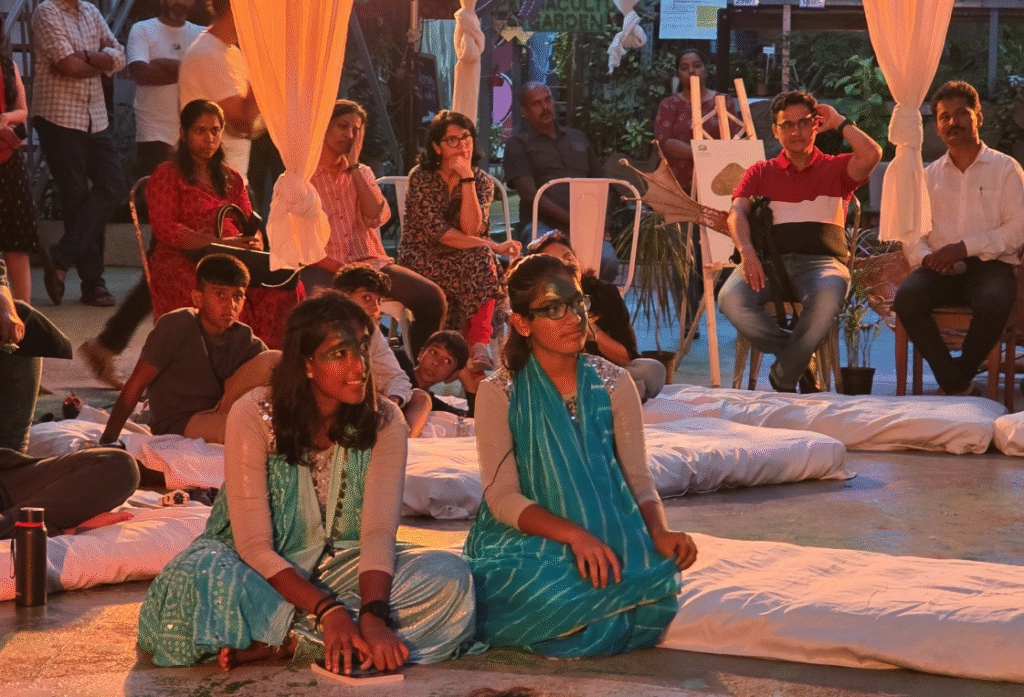rivers have voices too, children as stakeholders in bengaluru’s water story

What if a river could speak, what would it say to you?
At the Rivers of Western Ghats event in Bengaluru, it wasn’t adults but children who took on the voice of rivers, interviewing ecologists, poets, and conservationists.
They didn’t speak for nature. They spoke as nature.
From Awareness to Action in Bengaluru
It all began with a school project that turned into a movement.
After months of research, performances, and awareness campaigns, the Lakes Team from Sparkling Mindz Global School was invited to perform at major city events — turning classrooms into stages for civic dialogue.
Here’s how the ripples spread:
- Bangalore International Centre (April 2024): Their play “Bengaluru: Once a City of Lakes” reached over 50 citizens beyond the school community.
- Child-Centric Learning Ecosystem Conference (Sept 2024): They performed for 70+ policymakers, educators, and mental health experts.
- Namma Metro Performances (Jan–Feb 2025): Over 72 shows across four metro stations gathered 500+ petition signatures for lake restoration. Commuters paused, watched, and reflected. Awareness flowed.
- Paani.Earth’s Rivers of Bengaluru Installation (Sept 2025): Children were invited as partners, not spectators, meeting over 200 people during the exhibition.
- Mycelium Collective’s “Rivers of Western Ghats” (Sept 2025): Here, children became rivers themselves, hosting a panel that blurred the line between science, poetry, and empathy.
Their message was simple but profound — the health of a city’s water mirrors the health of its people.
We, the Children of Bengaluru
Their curiosity didn’t stop at performances. It led them into research — both primary and secondary — to truly understand their city and its water systems.
They discovered:

- Bengaluru’s population had grown from 7.5 lakh in the 1950s to 1.4 crore in 2025. Almost everyone here is an immigrant, with no real roots or sense of belonging. Our relationship with the city is largely transactional. But when the city struggles — as it does now — who really claims ownership?
- Sitting atop granite hills, 900m above sea level, Bengaluru is a tropical paradise blessed with rain and mild weather — once rightly called the Garden City. Pollution and climate change are slowly eating away at that charm. Who is responsible?
- The city’s interconnected lake system once ensured an abundant water supply. These lakes — all man-made — were community hubs for washing, bathing, and connecting. Even today, dhobi ghats stand as reminders of that communal stewardship. But when public water bodies lose their communities, who remains accountable?
- Encroachment on lakes and wetlands has broken the city’s water lifelines. Ironically, the result is both flooding and scarcity. A thriving system was dismantled without foresight. Now, the question is — when adversity strikes, will our children roll up their sleeves to rebuild, or stand aside and complain?
The children’s answer was clear: they chose to act.
Understanding Our Backyard
At Sparkling Mindz, learning doesn’t stop at the classroom door — especially when the city itself becomes the textbook. Using a humanity-centred design approach called P2P Labs (Problems to Projects Labs), children learn to unpack complex, messy, real-world challenges with curiosity and empathy.
Through these experiences, children are learning something schools rarely teach — ecological citizenship. They now see lakes and rivers not as scenery, but as neighbours. Not as “resources,” but as relationships.
So when Bengaluru’s water crisis hit, here’s what they did:
- Questioned deeply — starting with “why” and “how” instead of “who to blame.”
- Researched and mapped the city’s water sources and distribution systems, piecing together how Bengaluru once sustained itself through lakes and wetlands.
- Stepped into others’ shoes — viewing the problem through the eyes of citizens, vendors, policymakers, and even the lakes themselves.
- Connected the dots — creating a systems map that revealed how encroachments had choked Bengaluru’s natural water recharge network.
- Linked cause and effect — understanding that building over lakebeds doesn’t erase water; it just displaces it, causing both floods and scarcity.
- Took action — launching an awareness campaign and culminating it in their original performance, “Bengaluru: Once a City of Lakes,” which brought their research and reflections to life.
- Led by example — starting water budgeting and conservation practices in their own homes and communities.

What began as a school project evolved into a living lesson in responsibility, empathy, and hope — children learning not just about their city, but with it.
Children as Stakeholders, Not Spectators in the City Planning
When children are trusted as change-makers, magic happens.
They research, question, perform, and persuade — not out of obligation, but out of genuine care. As new opportunities open up in water education and awareness around rivers, lakes, and ecology, this journey continues to flow forward. We hope to connect with more changemakers who recognise children as partners and voices in the conversation — not empty vessels to be filled, but active stakeholders shaping the world they will inherit. And that’s the kind of education that might just save our future — one river, one child, one act at a time.
This story is part of an ongoing Urban Voices series by the author exploring how children in Bengaluru are rediscovering their city, its ecology, and their role as young change-makers. Read the first article here.
